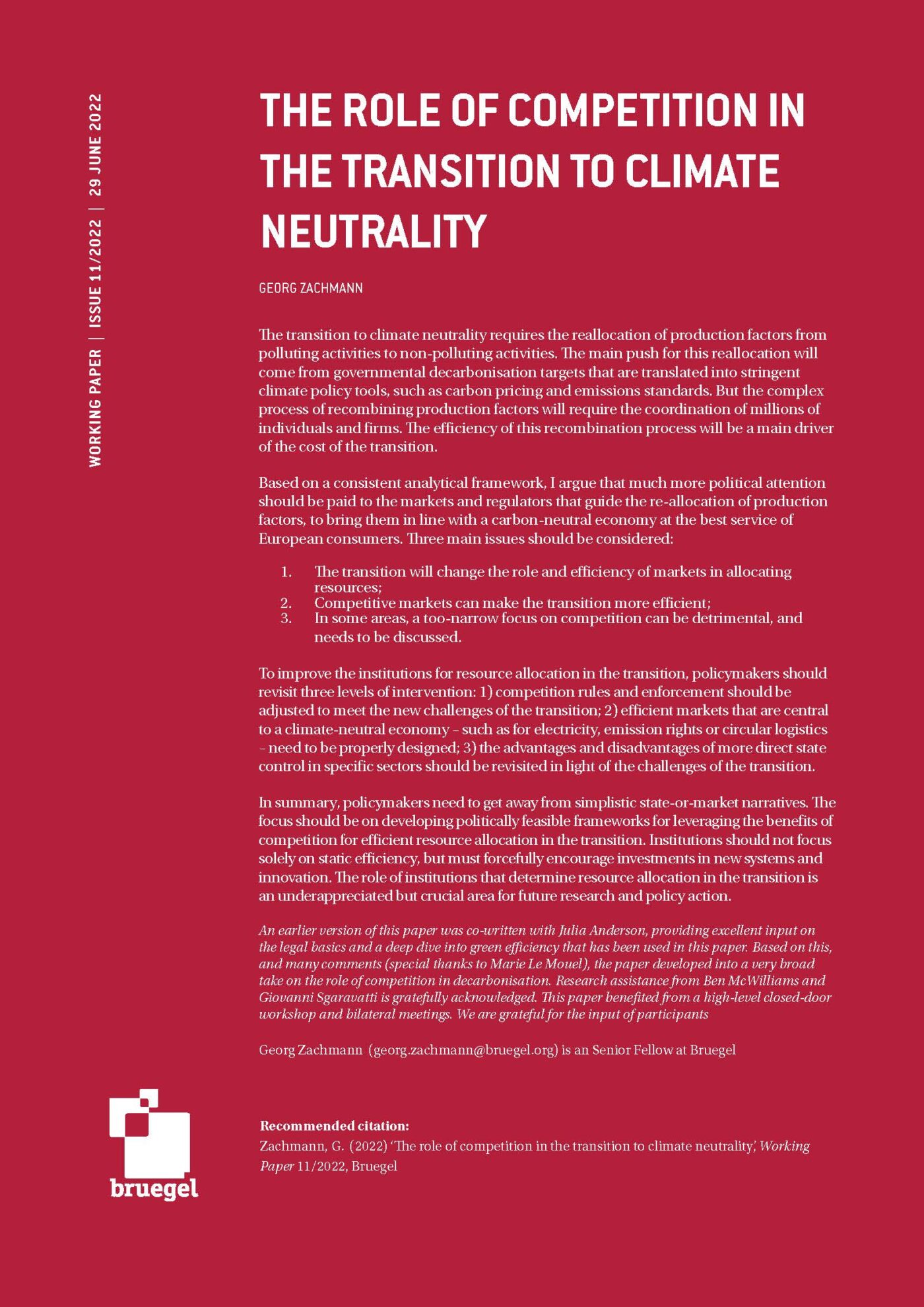Blog Post
The knowns and unknowns of the European competitiveness debate
Micro-economic features of economic systems can have a major impact on national performance. Policymakers should therefore reconfigure their scoreboards to reflect the roles played in a country’s economic growth by large internationalized firms, global value chains or resource reallocation.
This op-ed was originally published in Economonitor.

In the post-crisis economic policy debate, few words have been mentioned as often as ‘competitiveness’ which, according to conventional wisdom, should be ‘revamped’ for Europe. But what do we really know about ‘competitiveness’ and the related policy levers?
A recent strand of economic research, examined in a new Bruegel Blueprint edited by Altomonte and Békés (2016), has looked at new developments in this area, taking a fresh look at the issue of competitiveness in general, and the European case in particular. Three general findings have emerged:
- There are many aspects of competitiveness that we assume we understand, but we increasingly realise we do not get right, because the traditional policy toolbox has become outdated in the post-crisis global context;
- There are interesting new aspects of competitiveness that we are getting to know, mostly related to firm-level, rather than industry- or country-level, measurements;
- Our ability to assess more precisely the dynamics of competitiveness is seriously hampered, at least for Europe, by existing data limitations, and hence there are still many aspects of the problems that remain unknown.
Learning and unlearning in the competitiveness debate
The traditional approach of policymakers has been to define competitiveness through aggregate performance indicators such as long-run GDP growth, job creation or components of the balance of payments, and then to try to understand its determinants with the idea of influencing them. Plausible drivers of performance have been identified, such as unit labour costs and wage dynamics, access to capital, R&D spending, share of renewable energy or corruption. The idea is that the right recipe for competitiveness would lead to a resumption of a country’s growth and welfare.
While a coherent set of institutions and a generally sound economic environment certainly fosters positive developments in competitiveness, recent research increasingly recognises that national performance is, to a substantial degree, the outcome of idiosyncratic growth episodes taking place within specific firms, regions or cities. As argued by European Central Bank President Mario Draghi, “a competitive economy, in essence, is one in which institutional and macroeconomic conditions allow productive firms to thrive. In turn, the development of these firms supports the expansion of employment, investment and trade.”
This notion of ‘granularity‘ – or a finer, more detailed understanding of competitiveness – is supported by a wide range of recent evidence, and is confirmed as one of the four key messages in Altomonte and Békés (2016). The concept in the economic literature captures the idea that economic performance can be driven to a great extent by a few large, very productive and internationally active firms that play a dominant role in regional and national economic performance. This result is persistent across different countries, industries and measures. Although industrial differences might be important, the difference between the average productivity of firms in the best 10% and worst 10% of industries is about half of the difference between the top 10% and lowest 10% of firms in a median industry. The top 1-5% of firms is responsible for 70-90% of growth in value added, exports or foreign direct investment (see Syverson, 2004, for the US; Mayer and Ottaviano, 2007, for early evidence on Europe, and Lopez-Garcia et al, 2015, for a recent assessment of different European countries).
As a result, the microeconomic characteristics of a population of firms play a relevant role because they can significantly affect aggregate outcomes. Barba Navaretti et al (2016) show that some measure of competitiveness (eg the ability to export) are not captured merely by the average performance of firms, but also by higher moments (ie variance and asymmetry) of the underlying firm-level distribution. Furthermore, Békés and Ottaviano (2016) show how regional or urban performance, even more than national performance, ends up being driven by a handful of particularly large or productive firms. The role of externalities such as knowledge spillovers to neighbouring firms makes granularity even more salient.
As a result, average (or aggregate) measurements (such as R&D spending, or productivity) –the parameters on which most policies are based – do a poor job of grasping the actual level of competitiveness within countries (regions) and between them. Similar policies dictated ex-ante by similar average competitiveness measures at the country level (eg unit labour costs) might end up producing very different outcomes ex-post, because of the underlying heterogeneity of firm performance in the different countries. A policy might, for example affect differently a region of mediocre firms and region with a mix of high and low productivity firms. Ignoring that information would imply a very imprecise assessment of actual competitiveness.
Another finding from recent research into competitiveness that uses micro data is that a significant part of the differences in countries’ productivity levels can be accounted for by differences in allocative efficiency (see Bartelsman et al, 2013). That is, aggregate productivity in a country might, in part, be lagging because inputs (labour or capital) are not allocated efficiently between firms within an industry. Fontagnè et al (2016) and di Mauro and Ronchi (2016) show how a misallocation of resources in the labour market because of institutional rigidities/frictions (eg centralised wage-bargaining institutions) hinders a proper alignment of wages to firms’ productivity, leading to impaired competitiveness dynamics. Dysfunctional labour markets are however not the only source of misallocation. Gopinath et al (2015) show how capital misallocation within sectors correlated with poor aggregate productivity (especially for southern European countries: Italy, Spain and Portugal) during the 2009 crisis. Overall, more efficient reallocation of resources away from poorly-performing firms to the most productive firms provides a potential new channel for boosting aggregate productivity. The benefits derived from reallocation are considerable: approximately one third of productivity growth.
Beyond granularity and reallocation, another key issue in national competitiveness, from the evidence we have been able to collect, is international activities. The world economic picture has been recently characterised by the emergence of global value chains (GVCs), ie the fragmentation of production activities and the international dispersion of tasks. Because of this increasing geographic disintegration of production, gross exports from a given country include not only the value added generated domestically, but also the foreign value added generated in another country, imported into the home country as an intermediate, and re-exported. GVC-induced trade in intermediaries is different from traditional forms of trade, and this can clearly be seen in the dissimilar adjustment process of the trade components in the aftermath of the crisis, as illustrated in Altomonte, Colantone and Zaurino (2016). The modalities through which individual firms access international markets and participate in GVCs are all key drivers of external competitiveness. Information on the position and degree of participation of firms within GVCs is therefore another key element in a proper assessment of a country’s competitiveness.
Last but not least, another key development in the analysis of competitiveness in a globalising world is related to new findings about the importance of non-price factors in driving exports (see Martin and Mayneris, 2015). The standard price (cost) competitiveness argument states that the lower the unit cost of production of a good or service, the more competitive the firm /industry that produces it. However, recent research has determined that about one third of the variation in performance depends on competitiveness-enhancing channels that are alternatives to cost reductions, such as investment in R&D or the improvements in the quality of the products. This non-price channel generates a positive relationship between the competitiveness of firms and the prices charged by firms for final goods, which is the opposite of how typical price-related competitiveness measures behave. Consumers value quality and are willing to pay a higher price for high-quality goods, as is the case for the luxury, aeronautical and electrical distribution goods sectors and/or brands, which play a key role in France’s exports (see Bas et al, 2016).
Better data for better competitiveness analysis
Assessing the competitiveness of a complex environment is by definition a complex exercise that requires access to extremely detailed data. A common element in all the research results we have presented is their reliance (in addition to novel analytical methodologies) on novel datasets in which firm-level or individual-product level information is disaggregated. Unfortunately, the current availability of data collected by EU institutions does not enable a proper assessment of any of the new channels of competitiveness for all EU countries in a systematic fashion.
However, the problem is not that data does not exist. As discussed by Castellani and Koch (2015), national statistical offices have access to a wealth of micro-based data that could constitute a very promising starting point for any analysis of competitiveness in Europe. The problem is that the data is hard for researchers to access and, when it is accessible, comparability is limited. In those cases in which micro-based data is made accessible and comparable across countries through specific projects (Such as the ECB Competitiveness Research Network), these projects cover a limited time period, again preventing a revamp of the availability of policy-relevant information for the EU.
To resolve this, there are three major options: a single Eurostat framework of centralised micro-data, a distributed micro-data approach harnessing national data with co-ordination, and a regular pan-European survey (for details about these options, and exercises to date, see Section 4 of Castellani and Koch, 2015).
The first option would be the construction of a Pan-European Dataset with a joint infrastructure framework for the production and compilation of business statistics. It would come with an appropriate legal foundation and new administrative mechanisms to facilitate the sharing of information and services.
The second option, the Distributed Micro-Data Approach, would allow researchers to work with datasets that remain at national institutions but with data harmonised through common statistical codes. Projects such as CompNet or ESSLait provided important insights into the huge opportunities of this, as well as the serious drawbacks without a formal structure. This would require small but permanent funding for national institutions.
The third option, a Pan-European Survey, would be a multi-scope cross-country survey, through which researchers would gather information on a wide range of firms’ activities and performance indicators. This would follow in the footsteps of the Community Innovation Survey or the EFIGE survey. This requires very limited official co-ordination but requires commitment and regular funding.
Each of these options has advantages and disadvantages, but any of the three would dramatically improve the scope of policy analysis and hence improve the EU-level policy toolkit. Without a European data space, we cannot test theories and bring insights to policy, and policymakers cannot see scoreboard of micro-based measures that could help design better policies.
Republishing and referencing
Bruegel considers itself a public good and takes no institutional standpoint. Anyone is free to republish and/or quote this post without prior consent. Please provide a full reference, clearly stating Bruegel and the relevant author as the source, and include a prominent hyperlink to the original post.









